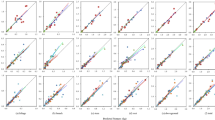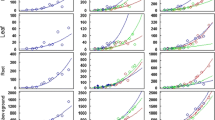Abstract
The carbon (C) stocks of forests are usually calculated from inventory-based estimates of the stem volume, tree-species-specific wood densities, biomass expansion factors (BEF) and functions for the mass of branches and needles/leaves, and the C concentration. However, reported BEFs in the literature are inconsistent, and especially the reliability of the C stock estimates for young stands is unknown. We describe an efficient method for deriving locally valid functions in order to estimate the aboveground biomass of young Norway spruce (Picea abies Karst.) stands. Data were collected from two adjacent stands, representing the treatment ‘Control’ and ‘Fertilized’ of an amelioration experiment. The stem volume was derived from Mass Tables as a function of diameter and height and was converted to stem mass with a species-specific conversion factor. Subsamples of branches from different positions within the canopy were selected by probability proportional to size (PPS) sampling. Needles and branches were weighed separately. The obtained expansion functions for branch and needle biomass have dbh as the only input variable and are accurate (0.88<R2<0.96). Earlier published allometric functions carried a considerable bias, especially when applied for young stands. We found that differences in soil fertility do not alter the ratio between the masses of stems, branches, and needles. Regionally derived biomass expansion functions can be used for sites with different soil fertility, can greatly improve the estimate of the aboveground biomass, and can be generated with a modest effort of field and laboratory work.



Similar content being viewed by others

Abbreviations
- BF j :
-
Blow-up factor for quartile j
- dbh :
-
Stem diameter at breast height (cm)
- db i :
-
Diameter of branch i (cm)
- dc :
-
Stem diameter at the base of the canopy (cm)
- hc :
-
Height of the base of the canopy (m)
- hb i :
-
Height of branch i above the ground (m)
- i :
-
Index for branch number
- j :
-
Index for quartile of canopy
- m :
-
Stem mass (kg)
- mb i :
-
Fresh mass of branch i (kg)
- mb :
-
Total fresh mass of branch of tree (kg)
- mn i :
-
Needle dry mass of branch i (kg)
- mn j :
-
Needle dry mass of branches in quartile j of the canopy (kg)
- mn :
-
Total needle dry mass of individual tree (kg)
- mw i :
-
Wood dry mass of branch i (kg)
- mw j :
-
Wood dry mass of branches in quartile j of the canopy (kg)
- mw :
-
Wood dry mass of branch of individual tree (kg)
- RAN:
-
Random number
- sap :
-
Sap wood area (cm2)
- V :
-
Stem volume (m3)
References
Böswald K, Rumberg M, Schulte A (2000) Die Forstwirtschaft in der internationalen Klimapolitik. Forst Holz 21:691–696
Briggs E, Cunia T (1982) Effect of cluster sampling in biomass tables construction: linear regression models. Can J Forest Res 12:255–263
Brown S (2002) Measuring carbon in forests: current status and future challenges. Environ Pollut 116:363–372
Bundesholzwirtschaftsrat (1985) Österreichische Holzhandelsusancen 1973. Verlag der Wiener Börsenkammer, Wien, 1985 edition
Burger H (1953) Holz, Blattmenge und Zuwachs. Mitteilungen der schweizerischen Anstalt für das forstliche Versuchswesen XXIX:38–130
Droste zu Hülshoff Bv (1970) Struktur, Biomasse und Zuwachs eines älteren Fichtenbestandes. Forstwissenschaftliches Centralblatt 89:162–171
Eckmüllner O, Sterba H (2000) Crown condition, needle mass, and sapwood area relationships of Norway spruce (Picea abies). Can J Forest Res 30:1646–1654
Ellenberg H, Mayer R, Schauermann J (1986) Ökosystemforschung - Ergebnisse des Sollingprojektes 1966–1986. Eugen Ulmer, Stuttgart
Englisch M (1987) Versauerung von Waldböden durch Entnahme von Biomasse bei der Holzernte (Fichte) – Untersuchung der Auswirkungen verschiedener Nutzungsarten auf 17 österreichischen Standorten. Diplomarbeit, Universität für Bodenkultur, Vienna
Enquist BJ, Niklas KJ (2002) Global allocation rules for patterns of biomass partitioning in seed plants. Science 295:1157–11520
Gaffrey D, Saborowski J (1999) RBS, ein mehrstufiges Inventurverfahren zur Schätzung von Baummerkmalen. Allgemeine Forst Jagdzeitung 170:177–183
Gholz H, Grier C, Campbell A, Brown A (1979) Equations for estimating biomass and leaf area of plants in the pacific northwest. Technical Report 41, Oregon State University, Forest Research Lab
Hager H, Sterba H (1985) Specific leaf area and needle weight of Norway spruce (picea abies) in stands of different densities. Can J Forest Res 15:389–392
Jandl R, Starlinger F, Englisch M, Herzberger E, Johann E (2002) Long-term effect of a forest amelioration experiment. Can J Forest Res 32:120–128
Jenkins J, Chojnacky D, Heath L, Birdsey R (2003) National-scale biomass estimators for United States tree species. Forest Sci 49:12–35
Johann K (1968) Grösse und Verteilung des Zuwachses in Verjüngungsbeständen der Fichte. PhD Thesis, Universität, München
Johann K (1989) Sanfter Waldbau mit Chemie – ein Düngungs- und Meliorationsversuch zu Kiefer. ÖFZ 245:23–44
Johnson EW (1972) Basic 3-P sampling. Departmental Series 5, Agricultural Experiment Station, Auburn University, Auburn, Alabama
Krapfenbauer A, Buchleitner E (1981) Holzernte, Biomassen- und Nährstoffaustrag, Nährstoffbilanz eines Fichtenbestandes. Centralblatt für das gesamte Forstwesen 98:193–223
Marklund LG (1987) Biomass functions for Norway spruce (Picea abies L. Karst.) in Sweden. Technical Report 43, Department of Forest Survey, Swedish University of Agricultural Sciences
Marklund LG (1988) Biomass functions for pine, spruce and birch in Sweden. Technical Report 45, Dept of Forest Survey, Swedish Univ Agric Sciences
Pollanschütz J (1974) Formzahlfunktionen der Hauptbaumarten Österreichs. Informationsdienst der FBVA 153:341–343
Pollanschütz J (1976) Schaftholzvolumstabellen der Hauptbaumarten Österreichs. Informationsdienst der FBVA 164:1–2
Raisch W (1983) Bioelementverteilung in Fichtenökosystemen der Bärhalde (Südschwarzwald). Freiburger Bodenkundliche Abhandlungen 11:1–239
Schöne D, Schulte A (1999) Forstwirtschaft nach Kyoto: Ansätze zur Quantifizierung und betrieblichen Nutzung von Kohlenstoffsenken. Forstarchiv 70:167–176
Schreuder HT, Sedransk J, Ware KD (1968) 3-P sampling and some alternatives, I. Forest Sci 14:429–454
Schreuder HT, Sedransk J, Ware KD, Hamilton DA (1971) 3-P sampling and some alternatives, II. Forest Sci 17:103–118
Shinozaki K, Yoda K, Hozumi K, Kira T (1964) A quantitative analysis of plant form—the pipe model theory. Jpn J Ecol 14:97–105;133–139
Valentine HT, Hilton SJ (1977) Sampling oak foliage by the randomized-branch method. Can J Forest Res 7:295–298
Valentine HT, Tritton LM, Furnival GM (1984) Subsampling trees for biomass, volume, or mineral content. Forest Sci 30:673–681
Valentine HT, Baldwin VC Jr, Gregoire TG, Burkhardt HE (1994) Surrogates for foliar dry matter in loblolly pine. Forest Sci 40:576–585
Acknowledgements
We thank A Stemberger, E Stanz and G Krzemien for the able field work. A part of this paper was presented at the COST E-21 meeting on ‘Biomass Expansion Factors’, held July 4–5, 2002 in Besalú, Spain.
Author information
Authors and Affiliations
Corresponding author
Rights and permissions
About this article
Cite this article
Neumann, M., Jandl, R. Derivation of locally valid estimators of the aboveground biomass of Norway spruce. Eur J Forest Res 124, 125–131 (2005). https://doi.org/10.1007/s10342-005-0059-5
Received:
Accepted:
Published:
Issue Date:
DOI: https://doi.org/10.1007/s10342-005-0059-5



